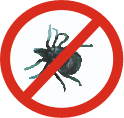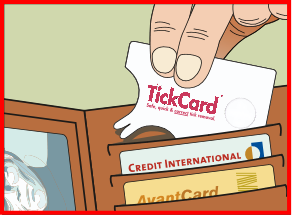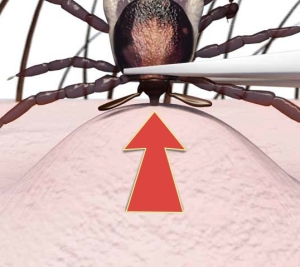How To Remove Ticks Safely, Quickly & Correctly:
Infection may also be triggered if you handle the tick incorrectly during removal!
Dr James Douglas of our UK National Health Service (NHS) posted a health information video about tick insects and Lyme Disease plus how to remove ticks safely and effectively with the right tool… You may recognize the brand 😉
See 4 min 50 for tick removal devices; 5 min 33 for demonstration of removal.
Stay Safe Outdoors

The UK Government fact sheet, “Tick bite risks and prevention of Lyme disease”, and other experts agree that it is extremely important to remove ticks safely, correctly and without delay due to the the risk of dangerous infection.
Basically, to keep the blood flowing, the tick will regurgitate into the host (you) after a few hours (expert opinions vary from 8 to 24hours ) but may occur sooner if you handle the tick incorrectly during removal.
1) You need to grip the head of the tick close to the skin without squeezing it’s body.
If the tick’s body is compressed it is likely the tick will regurgitate into the host (you), therefore transmitting any dangerous disease it carries. DO NOT SQUEEZE ITS BODY !
TickCard ™ – Patented Technology

INSTRUCTIONS:
2. Gently push the card forward and upward with steady, even pressure.
3. Allow the tick to let go and be pulled out of the skin easily and effortlessly.
Remove small, not yet engorged ticks with the smaller notch.
NOTE: Normal tweezers do NOT work for tick removal! They squeeze the body, causing regurgitation. If you want to use tweezers you need special pointy tweezers.
The TickCard Offers Save and Correct Tick Removal With Important Advantages:
• Light and easy to keep with you in your wallet or bag at all times so you have it when you need it
• It offers a handy 3 x magnifying lens
IMPORTANT INFORMATION:
Conventional methods of removing ticks can be dangerous.
Ticks can carry dangerous microbes in their saliva and body fluids.

- Do not squeeze, stress or burn a tick – it may regurgitate or put more saliva into you. Do not use regular tweezers as they squash the body!
- Do not use petroleum jelly, oil or any chemical products before removing it.
- Never pull or twist a tick as its mouthparts may break off and remain in the skin.
- Avoid touching removed ticks. Dispose of ticks safely. Do not squash them between your finger nails.
- If possible disinfect the bite area after removal and wash your hands and the TickCard or any other removal tool with hot soapy water or some other disinfectant.
The TickCard™ can help you avoid potentially serious disease – keep it with you and don’t delay proper removal!

Credit-card size: Fits neatly between your other cards so you have it when you need it.
With a TickCard in your wallet you are always prepared.

After removal:
You can send your tick to the Public Health England’s Tick Recording Scheme. They will identify it for you and add the information to their database. (They will not test your tick for disease though. If you want such a service try here.)
Serious tick-borne diseases include Lyme borreliosis which is increasingly common throughout Europe (including the UK) and America. Symptom patterns vary from person to person. Early indications in the days after the bite can include flu-like symptoms, feeling unwell, a rash, headache, muscle pain, tender glands and sensitivity to temperature, sound and light.
Please seek medical advice promptly if you are concerned or experience any of the above symptoms! (Inside the UK call 111)
Please Note: A small red itchy patch is a normal body-reaction to a tick bite.
We also offer holistic and alternative self-help suggestions.

